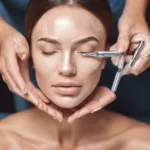22 November 2023
Discover the benefits, risks, and steps involved in this popular skin rejuvenation procedure
In the pursuit of flawless skin, individuals often turn to various skincare treatments. One such procedure gaining popularity is dermaplaning, a minimally invasive technique that removes the top layers of skin to reveal a brighter complexion underneath. This article will delve into the world of dermaplaning, exploring its benefits, risks, and the steps involved in the procedure.
What Is Dermaplaning?
Dermaplaning involves the use of a handheld surgical device called a dermatome, resembling a scalpel, to gently shave off thin layers of skin and hair. This procedure can be performed by dermatologists or other healthcare providers as a standalone treatment or in conjunction with other skincare procedures. Its primary purpose is deep exfoliation, which can help reduce the appearance of acne scars, fine lines, and wrinkles.
Dermaplaning vs. Dermabrasion vs. Microdermabrasion: What’s the Difference?
While dermaplaning, dermabrasion, and microdermabrasion are all methods of removing the top layers of skin, they differ in terms of the tools used and the extent of skin removal. Microdermabrasion involves spraying microcrystals or using a diamond-tipped device to exfoliate the skin, followed by suctioning to remove the dead skin cells. Dermabrasion, on the other hand, uses an electric rotating brush to remove the uppermost layers of skin, resulting in more dramatic results. Dermaplaning utilizes a scalpel-like dermatome for deeper exfoliation, capable of removing both skin and hair.
Benefits of Dermaplaning
Dermaplaning offers several potential benefits, including reducing the appearance of fine lines, minimizing acne scars and pitted skin, brightening dull and dry skin, and removing vellus hair, commonly known as “peach fuzz.” Additionally, dermaplaning can improve skin texture, treat sun-damaged skin, enhance the absorption of skincare products, and prepare the skin for other treatments or surgical procedures.
Who Is Dermaplaning Right For?
Dermaplaning is suitable for individuals looking to improve the texture and appearance of their skin. It can be particularly beneficial for those with sun-damaged skin, signs of aging, and certain skin conditions like rosacea. However, individuals with active acne breakouts, cold sores, skin rashes, burns, moles, or skin tags should avoid dermaplaning.
What Happens Before, During, and After Dermaplaning?
Prior to a dermaplaning session, a consultation with a dermatologist or aesthetician is essential to discuss goals, potential risks, and past reactions to skincare treatments. The clinician may advise certain preparations, such as cleansing the face and avoiding specific medications. During the procedure, a numbing cream or anesthesia may be applied to reduce discomfort. The clinician will then use the dermatome to carefully remove the top layers of skin. After the session, skincare products may be applied for deeper penetration, and immediate visible results can be expected. Temporary side effects such as redness or sensitivity may occur but typically fade within three months.
What Are the Risks of Dermaplaning?
While dermaplaning is generally safe, there are potential risks, including scarring, nicks and cuts, fever blisters, skin irritation, and thickened skin. However, these risks are relatively rare when performed by a trained professional.
Do You Need Multiple Dermaplaning Procedures?
Dermaplaning results are not permanent, and maintenance sessions are recommended to sustain the desired effects. Many individuals opt for monthly dermaplaning sessions to continually enhance the look and feel of their skin.
Conclusion:
Dermaplaning offers a non-invasive solution for individuals seeking smoother, brighter skin. With its ability to reduce the appearance of acne scars, fine lines, and wrinkles, dermaplaning has become increasingly popular. While it is important to consider the potential risks, seeking professional assistance from a dermatologist or aesthetician ensures a safer and more effective experience. If you’re looking to unveil a rejuvenated complexion, dermaplaning may be the answer you’ve been seeking.



